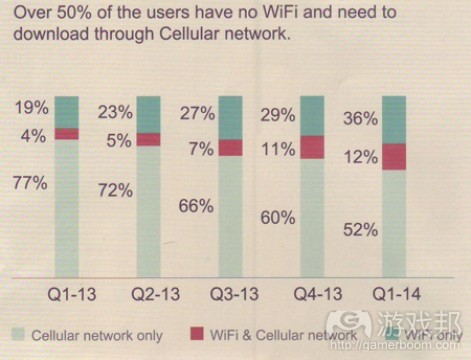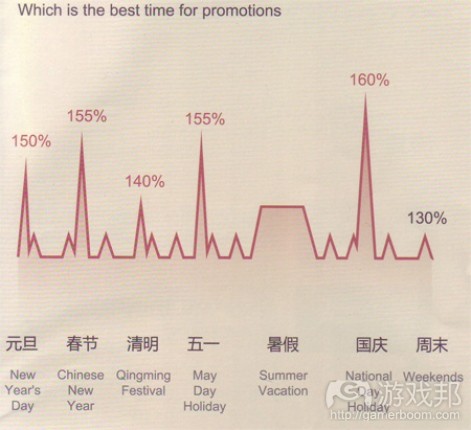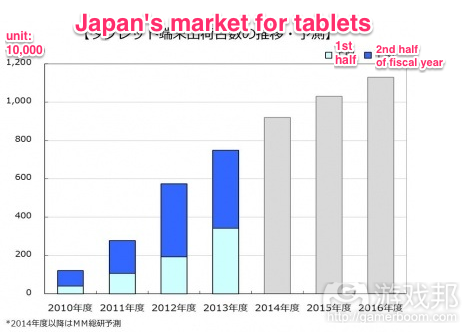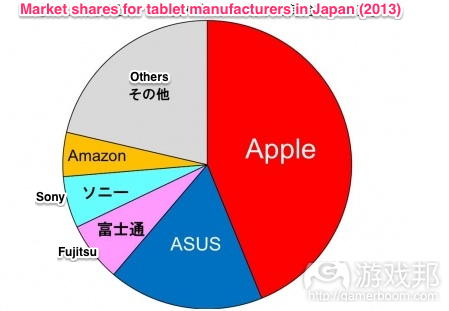每日观察:关注2014年亚太游戏市场规模等消息(5.26)
1)市场调研公司Newzoo最新报告预测,2014年亚太地区在全球增长的60亿美元的游戏收益中将占比82%。
全球电子游戏行业(游戏邦注:这包括PC、在线PC、社交、手机和主机游戏领域)今年收益增长8%,达到815亿美元。其中亚太地区所占市场份额从原来的42%增长至45%,预计将达368亿美元。
拉美地区在全球市场份额中仅占比4%,预计今年将增长14%,达到33亿美元。北美则将增长至222亿美元,占比27%。欧洲、中东、非洲三个地区(EMEA)收益为191亿美元,占比24%。
从整体来看,电脑屏幕仍是人们在2014的首要游戏平台,在全球市场中占比40%,比一年前增长9%。电视屏幕所占份额为29%,收益为234亿美元,比去年下降1个百分点。手持掌上设备在2014年份额将下降20%,而平板电脑游戏收益则将增长37%。总体移动平台游戏收益将增长19%,市场份额达27%(218亿美元)。
大型多人在线游戏收益将增长16%,达到178亿美元。游戏玩家今年在MMO游戏中的投入将比去年增长24亿美元。休闲网页游戏和中核PC/Mac游戏也将有所增长,移动领域游戏玩家将达12亿人。
2)据venturebeat报道,并购咨询公司The Corum Group高级分析师Alina Soltys最近指出,2013年游戏行业最大的十笔收购交易中,有9笔交易的买主来自亚洲,2012年前十大收购交易中则有8名亚洲买主。
目前全球规模最大的免费PC网游仍是腾讯/SmileGate旗下的《穿越火线》,去年收益达9.57亿美元。在去年前十大免费网游中,有半数来自亚洲,而中国腾讯在2013年游戏收益超过了53亿美元,超越动视暴雪(去年收益为48亿美元)世界上最大的游戏公司。
据GPC中国游戏市场报告显示,中国有8万家应用开发商每天发布约100款游戏。Soltys指出,PC客户端游戏所占收益仍然高达64.5%,网页游戏则占比15.4%,手机游戏虽然仅占比13.5%,但今年收益增长去高达250%。
3)据pocketgamer报道,在日前于北京举办的2014 GMIC大会上,应用发行商斯凯网络科技有限公司(Sky-mobi)指出,多数中国用户无法访问较快的WiFi网络,目前4G网络速度仅局限于北京和上海等一线城市。超过50%的中国用户无法使用WiFi,只能通过移动网络下载内容。
与此同时,越大的应用文件包的下载失败率就越高,中国用户的移动网络甚至无法顺利下载20MB大小的文件。
中国用户为IAP付费的时间轴不是以天来计数,而是以分钟来计算。4-8分钟就能决定用户是否愿意购买首个IAP。
与世界其他地区一样,节假日也是发行商推广应用的最佳时机,其中以春节和国庆等假期表现最为明显。
4)据serkantoto报道,位于东京的调研公司MM Research Institute最近发布了日本平板电脑市场报告,指出2013财年(2013年4月至2014年3月)日本平板电脑出货量为748万台,同比增长30.5%,略超过该公司去年5月份的预期。
MM Research Institute还预测到2015财年日本平板电脑出货量将达1000万台,这一增长趋势至少将延续到2016财年。
苹果仍是日本领先的平板电脑制造商,其市场份额在2013财年降至43.8%(2012年为52.5%)。华硕占比17.4%,富士通占比6.7%,索尼占比5.8%,亚马逊占比4.9%。
从平板电脑操作系统来看,Android首次以45.7%的日本市场份额超过iOS(43.8%),Windows则位居第三,占比10.5%。(本文为游戏邦/gamerboom.com编译,拒绝任何不保留版权的转载,如需转载请联系:游戏邦)
1)Asia will account for 82 percent of the $6B global game-market growth this year
Dean Takahashi
Gaming is growing, but mostly in Asia. Market researcher Newzoo is reporting today that Asia-Pacific will account for 82 percent of the $6 billion in global game revenue growth in 2014.
The industry is expected to grow 8 percent to $81.5 billion this year. Because of its faster growth rate, the Asia-Pacific region will grow its global market share from 42 percent to 45 percent, or $36.8 billion of the total.
The total revenues include all sectors of games including, PC, online PC, social, mobile, and console games. Latin America represents just 4 percent of the global market share, but it will grow 14 percent to $3.3 billion this year thanks to rising gross domestic product and online connectivity in the region.
North America will grow modestly to $22.2 billion in 2014, or 27 percent of total. Europe, Middle East, and Africa (EMEA) will be $19.1 billion, or 24 percent.
Globally, the computer screen will be the dominant way people play games in 2014, accounting for 40 percent of the worldwide market and growing 9 percent from a year ago. The TV screen will take 29 percent market share and $23.4 billion in revenues, down 1 percent from a year ago. Handheld console devices will drop 20 percent in 2014, offset by a 37 percent growth in tablet revenues. Overall mobile will grow 19 percent in 2014 and account for 27 percent market share, or $21.8 billion.
Massively multiplayer online games will grow 16 percent to $17.8 billion in revenue. Gamers will spend $2.4 billion more on MMOs in 2014 than in 2013.
Casual web games and midcore PC/Mac games will grow modestly. Mobile will reach 1.2 billion gamers.(source:venturebeat)
2)The DeanBeat: How far will the advantage swing to Asia in games?
Dean Takahashi
Free-to-play games were born in Asia, and it’s easy to see why gaming is growing at a faster clip over there. In fact, the largest free-to-play PC online game in the world is Tencent/SmileGate’s CrossFire, which generated $957 million in revenues last year.
Five of last year’s top ten free-to-play online games came from Asia. It’s worth noting that China’s Tencent, the majority of owner of League of Legends creator Riot Games, generated more than $5.3 billion in revenue from games in 2013, making it the largest game company in the world, eclipsing even Activision Blizzard with $4.8 billion.
It’s easy to see where this is going. Asia is going to be the king of the games business. In fact, it already is. The question is just how much of the business the Asian game companies will own. Alina Soltys, a senior analyst at M&A advisory firm The Corum Group, noted that nine of the top ten acquisitions in gaming in 2013 had Asian acquirers, compared to eight of the top ten in 2012.
Asia will account for 82 percent of the growth in the game business this year, according to a new report today from market researcher Newzoo.
“China as a country and mobile gaming as a market segment grew even more than anticipated” in 2013, said Peter Warman, chief executive of Newzoo. “As Asia continues to grow at a staggering pace and business models and game devices in the East and West have become more aligned, the games market is becoming a truly global playground.”
As a result, Asian games will generate $36.8 billion in revenues, or 45 percent of the $81.5 billion total in 2014, Newzoo said. North America, meanwhile, will grow modestly to $22.2 billion in revenues, or 27 percent of the total. Europe and nearby regions will grow to $19.1 billion, or 24 percent.
As the Electronic Entertainment Expo (E3) video game trade show approaches in early June, it would be good to remember these facts. No region can take its game industry economy for granted. I was just in Angouleme, France, for the Video Game Economics Forum. There, the talk was all about how the region can regain its vibrancy in games, similar to places like Montreal, Canada; Helsinki, Finland; and Silicon Valley. And in Silicon Valley, where I live, it seems like everybody wants to learn from the fast growth of mobile and online gaming in Asia. The grass is always greener somewhere else.
In the U.S., the overall game business was flat in the first quarter, partly because Nintendo is slipping dramatically even as Sony and Microsoft gain with their next-generation hardware and software sales. Microsoft hopes that it can grow faster by launching its Xbox One video game console in China in September, ending a 13 year ban on consoles there.
In China, there are 80,000 app developers who are releasing about 100 games a day, according to GPC China Games Market Report. PC client games still account for 64.5 percent of revenues, while web games are 15.4 percent, Soltys noted. Mobile games are 13.5 percent, but revenues grew 250 percent in the year.(source:venturebeat)
3)Why game file size remains critical for success in China
By Jon Jordan
We all know the Chinese mobile games market is different from other markets. But is that really so?
Perhaps it’s more correct to say that the Chinese mobile games market just reflects more extreme consumer behaviour than other markets.
Certainly these graphs from literature we picked up at the GMIC Beijing 2014 conference from app distribution company Sky-mobi demonstrates some intriguing facts.
Many – if not most – consumers don’t have access to fast wifi connections and hence are limited to a cellular network, with 4G speeds only available in the big Tier 1 cities such as Beijing and Shanghai.
Network access
But, this being China, the situation is changing quickly as this graph shows.
Impact of file size
Yet, it’s these sort of technical issues that mean file size remains a key issue in terms of distributing games. That’s why so many of the big Chinese Android app distribution channels are based around sideloading from PC.
Chinese connections are just not reliable enough even for downloads of 20 MB. That’s one of the reasons Sky-mobi has built its business around pre-installing content in retail locations.
Chinese consumers might not like to pay for IAP in their mobile games – who does? But this graph shows that if they do, that make that decision very quickly.
Initially I thought the time axis was measured in days. It’s not. It’s minutes.
4-8 minutes is the peak period for willing to pay for your first IAP, apparently.
And finally, what are the peak times during the year in terms of using promotions to drive usage? Note this graph isn’t really to scale. There are 52 weekends in the year, making it the best time to engage with players – much like the rest of the world then.(source:pocketgamer)
4)Japan’s Tablet Market Continues To Grow, Apple Loses Market Share
by Serkan Toto
Tokyo-based MM Research Institute released an overview on the Japanese market for tablets yesterday.
According to the report, a total of 7.48 million units were shipped domestically in fiscal 2013 (April 2013-March 2014), which is up 30.5% year-on-year.
This number is slightly above the projection MM Research released last May.
MM Research has raised estimates for 2014 and 2015 as well, now expecting tablet shipments in Japan to top 10 million as early as 2015. The upwards trend is projected to continue until at least 2016:
Here are the detailed numbers:
2012: 5.68 million units
2013: 7.48 million (+30.5%)
2014: 9.2 million (+23%)
2015: 10.3 million (+12%)
2016: 11.3 million (+11.3%)
Apple’s iPad Loses Market Share In Japan
While Apple continues to be the leading producer of tablets in Japan, its market share in fiscal 2013 dropped to “just” 43.8%, after reaching a whopping 52.5% in 2012.
Here is how MM Research breaks down the market by manufacturer:
Here are the detailed numbers for each manufacturer:
Apple: 43.8%
Asus (Nexus): 17.4%
Fujitsu: 6.7%
Sony: 5.8%
Amazon: 4.9%
In terms of tablet operating systems, MM Research finds that with 45.7% (slightly up from 42.4%), Android for the first time overtook iOS (43.8%) on the Japanese market. Windows comes in third with 10.5%.(source:serkantoto)















































 闽公网安备35020302001549号
闽公网安备35020302001549号